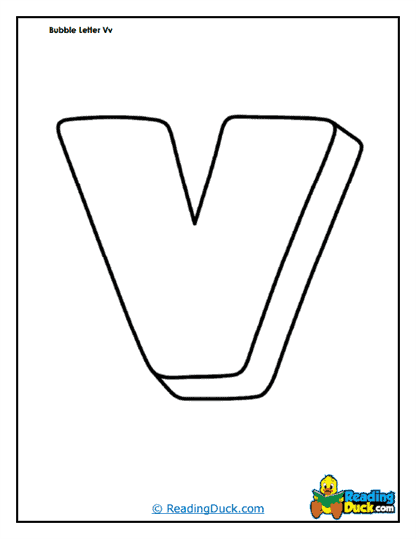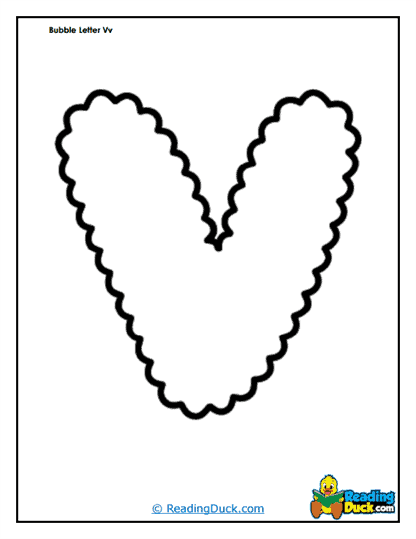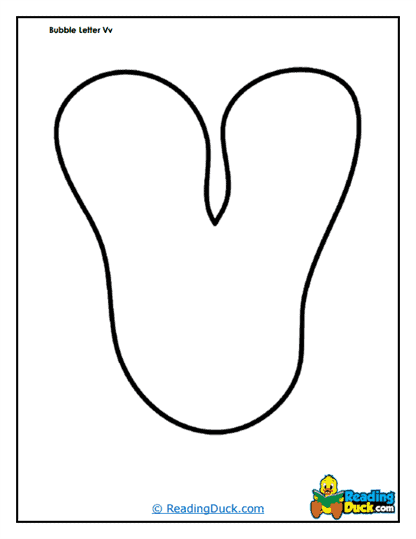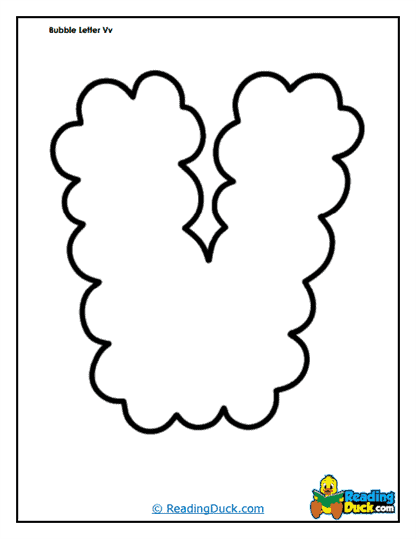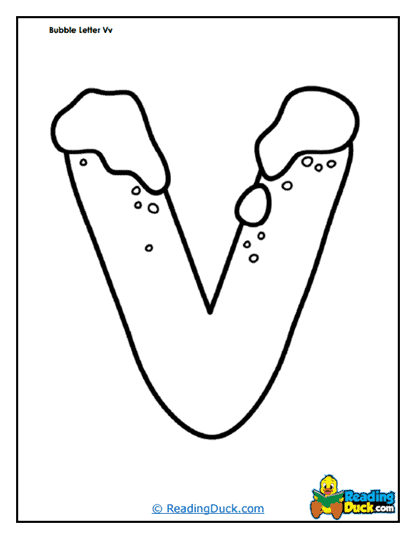Bubble Letter Vv Worksheets
About Our Bubble Letter Vv Worksheets
Bubble-letter worksheets serve as a dynamic and interactive tool for learning, combining creativity with foundational skills. These "puffy" or inflated letters capture attention and transform learning into an engaging experience, particularly for younger learners. For the letter "V," tracing bubble letters is a fun way for children to practice fine motor skills, hand-eye coordination, and proper letter formation. As children trace the curving lines and points of a bubble "V," they develop muscle memory essential for writing. This activity is not just about repetition-it’s about making the process visually stimulating and enjoyable, fostering a positive attitude toward practicing handwriting skills.
Coloring activities featuring bubble "V" letters take the engagement a step further, encouraging creativity while also promoting focus and attention to detail. Children can personalize their bubble "V" designs, perhaps imagining them as balloons, animals, or vibrant abstract shapes. This creative outlet enhances artistic expression, while the act of staying within the lines refines precision. In addition, such tasks help develop patience and a deeper connection to the learning material, making the letter "V" more memorable. By incorporating colors, textures, and even themes, these worksheets can seamlessly blend literacy learning with art.
Beyond tracing and coloring, worksheets for the letter "V" can include activities that challenge recognition and contextual understanding. For example, finding the letter "V" in a group of words, pictures, or even patterns strengthens a child’s ability to identify letters in different contexts. Connecting dots to form the letter "V" combines logical sequencing with letter formation practice, giving children a sense of accomplishment when they see the "V" emerge. Completing words that begin with "V," such as "van" or "vase," provides an introduction to vocabulary building, showing how letters function within language. Together, these activities provide a holistic approach to learning the letter "V," blending tactile, visual, and cognitive methods to keep children engaged and growing in their literacy journey.
How Can They Help Young Students?
Letter Recognition
Bubble Letter Vv Worksheets are an excellent resource for teaching children to recognize the letter "V." By consistently engaging with these worksheets, young learners become familiar with the distinct shape and features of the letter, which helps them identify it in a variety of contexts such as books, signs, and classroom displays. For example, recognizing "V" in a stop sign or on a page enhances their reading fluency and awareness of written communication in the world around them. Visual exposure to "V" in different fonts and styles further strengthens this recognition. These activities ensure children can distinguish "V" from other letters, an essential first step in learning the alphabet. Over time, their ability to identify "V" without prompts builds confidence in early literacy skills.
The sharp, angular design of the letter "V" makes it visually distinct, helping children recognize it more easily compared to other letters. Its simplicity allows children to quickly identify it in words, improving their reading skills. When learning to write "V," the clear structure of two intersecting lines helps children remember its shape without confusion. This clarity in design makes "V" easier to differentiate from similarly shaped letters, such as "U" or "W." As children practice forming the letter, the straightforward lines enhance their ability to write it accurately and confidently. These distinct characteristics of "V" ensure that even early learners can recognize and reproduce it without frustration.
Handwriting Practice
Tracing and writing bubble letters on these worksheets helps children refine their handwriting skills. By repeatedly tracing "V," children develop the fine motor control necessary to form the letter with accuracy and consistency. This practice strengthens the small muscles in their hands, which are critical for tasks like gripping pencils and other tools. As they progress from tracing to writing independently, they build muscle memory for forming the letter correctly, ensuring their handwriting is legible. Additionally, consistent practice helps children develop better hand-eye coordination as they learn to guide their movements along the lines. This foundational skill extends beyond writing letters to drawing shapes and performing other precision tasks in their daily lives.
Phonics and Sound Awareness
They often include activities that pair the letter "V" with simple words like "van," "violet," and "vest." These word associations introduce children to the sound "V" makes, reinforcing their understanding of phonics. By saying the words aloud and connecting them to the letter "V," kids begin to grasp how this sound is used in language. Listening to and repeating the "vuh" sound helps them differentiate it from similar sounds, improving their auditory discrimination. These exercises also build a strong foundation for reading by teaching the relationship between letters and sounds. As they learn to blend the "V" sound with others, children gain skills that are crucial for decoding and pronouncing new words as they progress in literacy.
The letter "V" has a unique and consistent sound ("vuh"), which makes it simpler for young learners to associate the letter with its phonetic identity. Unlike letters such as "C" or "G," which can have multiple sounds, the "V" sound remains stable across nearly all words. This predictability makes it an ideal letter for introducing phonics concepts to children. Furthermore, the "vuh" sound is a voiced consonant, meaning it involves vocal cord vibration, which adds a sensory element to the learning process. As children feel the vibration while pronouncing "V," they create a multisensory memory of the sound, reinforcing their understanding. This stable sound also lays the groundwork for learning more complex phonics rules later on.
Creativity and Focus
The artistic aspect of these types of worksheets engages children in coloring, decorating, and personalizing their work. These creative activities encourage them to express their individuality while focusing on completing a task. For example, they might use crayons, markers, or stickers to embellish the letter "V," transforming the worksheet into a fun and interactive project. This combination of creativity and focus helps young learners develop longer attention spans and a sense of accomplishment as they complete each activity. Additionally, it fosters a positive association with learning by making the experience enjoyable and rewarding. The hands-on nature of these tasks keeps children engaged, even those who may struggle with traditional learning methods.
Vocabulary Building
Through exposure to words that start with "V," children expand their vocabulary in meaningful ways. For instance, worksheets might feature pictures and words like "van," "vest," and "violet," helping kids connect the letter to familiar objects and concepts. Associating these words with the letter "V" not only enhances their vocabulary but also strengthens their spelling and reading skills. Learning age-appropriate words creates a bridge between written language and the real world, making literacy feel relevant to their everyday experiences. As children recognize patterns in "V" words, they develop better phonetic skills, aiding in word recognition and retention. This enriched vocabulary becomes a building block for more advanced language skills later on.
The letter "V" appears in many simple, age-appropriate words that children encounter in their daily lives, such as "van," "vest," and "violet." Introducing these words not only expands their vocabulary but also connects learning to real-world experiences. For example, pointing out a "van" on the road or discussing the color "violet" during art activities reinforces the relevance of the letter "V." These associations help children understand how "V" is used in different contexts, making the learning process more engaging and practical. By repeatedly encountering these words in books, conversations, and visual aids, kids gain confidence in recognizing and using the letter "V" in speech and writing. This early familiarity with "V" words supports their overall language development, preparing them for more complex literacy challenges.
